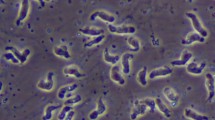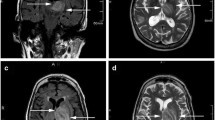Abstract
Balamuthia mandrillaris is a free-living ameba and an opportunistic agent of lethal granulomatous amebic encephalitis (GAE) in humans and other mammals. Its supposed routes of infection have been largely assumed from what is known about Acanthamoeba spp. and Naegleria fowleri, other free-living amebae and opportunistic encephalitis agents. However, formal proof for any migratory pathway, from GAE patients or from animal models, has been lacking. Here, immunodeficient mice were infected with B. mandrillaris amebae by intranasal instillation, the most likely natural portal of entry. By means of classical and immunohistology, the amebae are shown to adhere to the nasal epithelium, progress along the olfactory nerves, traverse the cribriform plate of the ethmoid bone, and finally infect the brain. A similar invasion pathway has been described for N. fowleri. The data suggest that the olfactory nerve pathway is a likely route for natural infection of the brain by B. mandrillaris amebae.

Similar content being viewed by others
References
Amaral Zettler LA, Nerad TA, O’Kelly CJ, Peglar MT, Gillevet PM, Silberman JD, Sogin ML (2000) A molecular reassessment of the leptomyxid amoebae. Protist 151:275–282
Anzil AP, Rao C, Wrzolek MA, Visvesvara GS, Sher JH, Kozlowski PB (1991) Amebic meningoencephalitis in a patient with AIDS caused by a newly recognized opportunistic pathogen. Arch Pathol Lab Med 115:21–25
Bakardjiev A, Azimi PH, Ashouri N, Ascher DP, Janner D, Schuster FL, Visvesvara GS, Glaser C (2003) Amebic encephalitis caused by Balamuthia mandrillaris: report of four cases. Pediatr Infect Dis J 22:447–452
Janitschke K, Martínez AJ, Visvesvara GS, Schuster FL (1996) Animal model Balamuthia mandrillaris CNS infection: contrast and comparison in immunodeficient and immunocompetent mice: a murine model of “granulomatous” amebic encephalitis. J Neuropathol Exp Neurol 55:815–821
Jarolim KL, McCosh JK, Howard MJ, John DT (2000) A light microscopy study of the migration of Naegleria fowleri from the nasal submucosa to the central nervous system during early stage of primary amebic meningoencephalitis in mice. J Parasitol 86:50–55
Kiderlen AF, Tata PS, Schäfer H, Özel M, Janitschke K (2000) Cytopathic activity of Balamuthia mandrillaris (Visvesvara 1993), an opportunistic causative agent of granulomatous amebic encephalitis. 19. Tagung der Deutschen Gesellschaft für Parasitologie. Köhler, Gießen, p 103
Kiderlen AF, Laube U, Radam E, Matzk P, Tata PS (2004) The ameba Balamuthia mandrillaris infects immunodeficient mice also by cutaneous and oral routes. Int J Med Microbiol 293 [Suppl 38]:54
Martínez AJ, Visvesvara GS (1997) Free-living and opportunistic amebas. Brain Pathol 7:583–598
Martínez AJ, Visvesvara GS (2001) Balamuthia mandrillaris infection. J Med Microbiol 50:205–207
Martínez AJ, Nelson EC, Jones MM, Duma RJ, Rosenblum WI (1971) Experimental Naegleria meningoencephalitis in mice—an electron microscope study. Lab Invest 25:465–475
Martínez AJ, Duma RJ, Nelson EC, Moretta FL (1973) Experimental Naegleria meningoencephalitis in mice—penetration of the olfactory mucosal epithelium by Naegleria and pathologic changes produced: a light and electron microscope study. Lab Invest 29:121–133
Rowen JL, Doerr CA, Vogel H, Baker CJ (1995) Balamuthia mandrillaris: a newly recognized agent for amebic meningoencephalitis. Pediatr Infect Dis J 14:705–710
Schuster FL, Visvesvara (1996) Axenic growth and drug sensitivity studies of Balamuthia mandrillaris, an agent of amebic meningoencephalitis in human and other animals. J Clin Microbiol 34:385–388
Schuster FL, Dunnebacke TH, Booton GC, Yagi S, Kohlmeier CK, Glaser C, Vugia D, Bakardjiev A, Azimi P, Maddux-González, Martínez GS (2003) Environmental isolation of Balamuthia mandrillaris associated with a case of amebic encephalitis. J Clin Microbiol 41:3175–3180
Shadrach WS, Radam E, Flieger A, Kiderlen AF (2004) The pathogenic ameba Balamuthia mandrillaris possesses cell-associated phospholipase A, lysophospholipase A and lipase activities. Int J Med Microbiol 293 [Suppl 38]:54
Visvesvara GS, Martínez AJ, Schuster FL, Leitch GJ, Wallace SV, Sawyer TK, Anderson M (1990) Leptomyxid ameba, a new agent of amebic meningoencephalitis in humans and animals. J Clin Microbiol 28:2750–2756
Visvesvara GS, Schuster FL, Martínez AJ (1993) Balamuthia mandrillaris, n.g., n.sp., agent of amebic meningoencephalitis in human and other animals. J Euk Microbiol 40:504–514
Acknowledgements
We thank Elke Radam for culturing the amebae, Dr. Kazimierz Madela for help with the CLSM, and Erik Kwidzinski as well as Prof. Ingo Bechmann for an introduction to transcardial perfusion. All experiments comply with current German law.
Author information
Authors and Affiliations
Corresponding author
Rights and permissions
About this article
Cite this article
Kiderlen, A.F., Laube, U. Balamuthia mandrillaris, an opportunistic agent of granulomatous amebic encephalitis, infects the brain via the olfactory nerve pathway. Parasitol Res 94, 49–52 (2004). https://doi.org/10.1007/s00436-004-1163-z
Received:
Accepted:
Published:
Issue Date:
DOI: https://doi.org/10.1007/s00436-004-1163-z




